|
"Most bark beaters
are about the size of an ordinary hammer and have been made out of wood,
stone, horn, pottery, ivory, shell, metal and even fish jaws set in wood."---1980,
Anne Leonard and John Terrell, "Patterns Of Paradise, The Styles And
Significance Of Bark Cloth Around The World," (Published by the Field
Museum of Natural history), p. 14.
"The use of
barkcloth, made of the inner bark of certain trees, is widespread in the
Pacific and is also found in Japan, South America and Africa."---2000,
Brij V. Lal & Kate Fortune, "The Pacific Islands, An Encyclopedia, Vol.
1" p. 546.
"Tapa is the generic name for
bark cloth produced throughout the South Pacific. The Samoan word for
bark cloth is siapo."---2007, Serie Barford, "Tapa Talk."
"Besides
its use in sacred ceremonies, the most important uses of barkcloth were
for bedding and clothing---often specially prepared and decorated for
people of rank."---2000, Brij V. Lal &
Kate Fortune, "The Pacific Islands, An Encyclopedia, Vol. 1" p. 547.
"Bark cloth
was put to various uses (in the
tributaries of the upper Amazon in Bolivia).
It was made into tunics or cushmas, aprons or breech-clouts, mosquito
nets, dance masks and covers"---1949, Alfred
Metraux, "Bark Cloth," "Handbook Of South American Indians,
Vol. 5" p. 67.
"No one who makes saipo (Samoan
barkcloth) and who has experienced
that silent communication ever again feels that she is making a mere
handicraft. Something deeply felt, like a prayer, gets into the saipo-maker's
very being, gets into her hands, and through her hands, gets into the
saipo itself. (Mary Pritchard,
1905-1992)"---2007,
Serie Barford, "Tapa Talk."

BARK BEATERS
AND BARKCLOTH
WORLDWIDE
4,000 + YEARS AGO TO PRESENT DAY
Bark beaters are simple and common utilitarian tool forms that were used
by people in many countries around the world. They have been in
continuous use for over 4,000 years. Bark beaters were used to pound,
hammer and tap the inner bark or bast of many different types of trees
in order to make the bark softer and thinner and to produce a material
called barkcloth. Clothing and bedding were two of its main uses. Other
uses include mosquito nets, dance masks and even paper. Early records in
Mexico
report that for the Aztec city of Tenochtitlan 24,000 packets of paper
were paid in tribute annually. In Fiji bark cloth was considered sacred
and in the godhouse it served as a pathway through which the god could
descend to the priest.
|
|
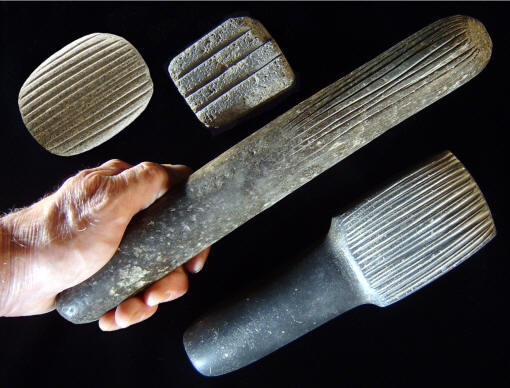
CLICK ON PICTURE FOR LARGER IMAGE
BARK BEATERS
MEXICO, ILLINOIS, GUATEMALA,
NEW GUINEA
This picture shows four examples of stone bark beaters that were
collected in four different countries. The two small examples are
grooved on their edges for hafting onto short wooden handles. The
larger bark beaters were made with handles attached. They all have
parallel grooves cut into the pounding surfaces.
The bark beater at top left is reported to have been collected on a
site somewhere south of the U.S. border possibly Mexico. The one to
the right was found on the Cahokia Mounds site in southern Illinois.
The bark beater at lower left was collected from the Kukukuku tribe
in the high mountain region of eastern New Guinea. The bark beater
at bottom right is reported to have been collected on a Maya site in
either Belize or Guatemala. |
|
|
It's difficult to know when bark beaters first
began to be used to
make barkcloth because bark does not survive for very long, especially
in tropical climates where termites are present. Finding a date for the
earliest use of bark beaters is all the more difficult because most bark
processing tools were also made of wood. |
|
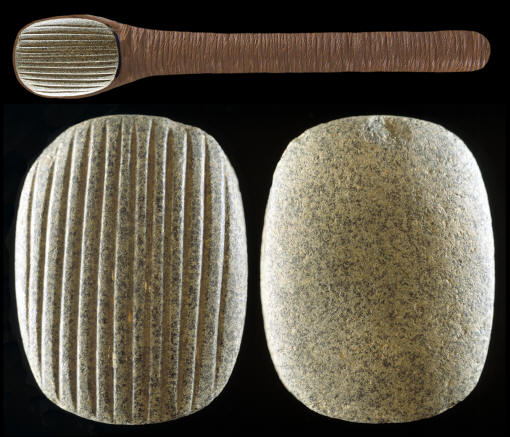
CLICK ON PICTURE FOR LARGER IMAGE
BARK BEATER
MEXICO
This
bark beater was found somewhere south of the U.S. border. It has a
hafting groove carved around its edges for attaching to a handle. The
picture at top shows a computerized image of how it might look with
a handle. One side of the hammering surface is plain and the other
side has the typical parallel grooves cut into its surface. It
measures 2 15/16 inches (7.5 cm) long. |
|
|
The oldest evidence of bark cloth was discovered on a site in
Peru where fragments of this material was discovered and dated to 4,000
years ago. Bark cloth was also in use in southeast Asia and Indonesia as
early as 3,000 years ago. There are also written records that indicate
that bark cloth was in use in northern China about 2,600 years ago. It
may be logical to assume that future research will discover even earlier
dates for bark cloth production. |
|
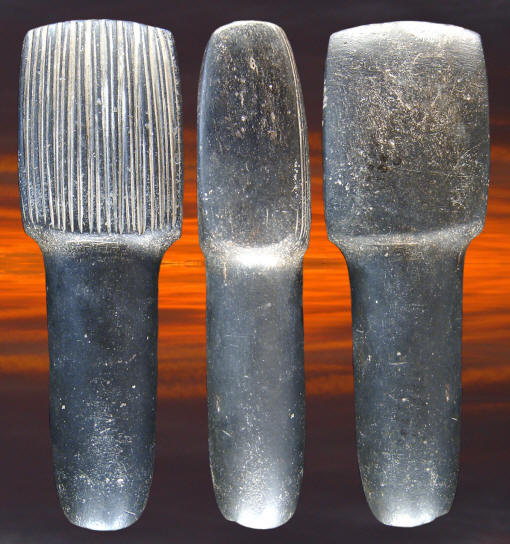
CLICK ON PICTURE FOR LARGER IMAGE
BARK BEATER
MAYAN CULTURE
GUATEMALA
This
Maya culture stone bark beater was collected in either Guatemala or
Belize. It's a highly developed form that is similar to some wooden bark
beaters. It has a rectangular parallel grooved pounding surface and
a short handle. It's made of a dark fine grain stone that was pecked
into shape with a hammerstone and ground smooth. It measures 8 inches (20.3 cm) long and 2
1/2 inches ( (6.3 cm) wide. |
|
|
Large numbers of bark beaters were produced during the 4,000
year period we know they were in use. These specialized tools were made
of just about every available material. Bark beaters were made of wood, stone, horn, pottery, ivory, shell,
whalebone,
metal and even the jaws of fish set in wood. The oldest surviving bark
beaters are made of stone. The most common material they were made from,
at least in the Pacific Islands, is wood. |
|
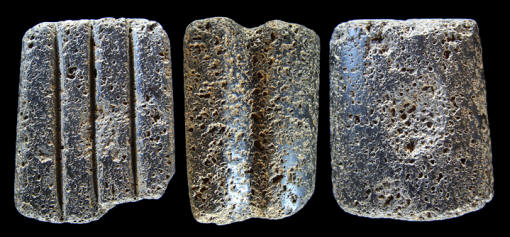
CLICK ON PICTURE FOR LARGER IMAGE
BARK BEATER
CAHOKIA MOUNDS SITE
SOUTHERN ILLINOIS
This unique and
out-of-place artifact was discovered several years ago in a
cultivated field on the Cahokia Mounds site by Joe Becker. By its
description it is a bark beater but this type of artifact has not
been reported on any other Mississippian site in the U.S. It seems
to be made of a type of volcanic stone that would suggest a source
far to the south in Mexico. If that is true, the only other
comparison that could be made to another out-of-place object is the
Obsidian scraper that is reported to have been found on the Spiro
Mounds site in Oklahoma. The Obsidian has been identified as coming
from a source located at Pachuca, Hidalgo, Mexico. If this bark
beater was brought to Cahokia from Mexico it would suggest that bark
cloth manufacturing technology would also have come with it.
This three-quarter grooved rectangular bark beater has one
very flat hammering surface that has been cut with three deep
parallel grooves. The opposite surface is rounded. A pitted area in
the center indicates that it was also used as a hammer. Use
wear polish in the hafting grooves indicates that it was once hafted
onto a handle. The surface is partially polished but peck marks and
the natural pitting of the stone are still evident all over its
surface. One end also has what appears to be either red ochre or red
clay adhering to the surface. This bark beater measures 2 1/2
inches (6.4 cm) long, 2 inches (5.1 cm) wide and 1 3/4 inches (4.5
cm) thick. |
|
|
There are three basic types of "stone" bark beaters. One
type has a short handle and pounding head incorporated into one unit. Another
type is a rectangular or oval hammering head that is grooved along the
edges so that it could be hafted onto a short wooden handle. These two
types of bark beaters also have parallel grooves cut into the flat surface
on one side of the pounding head. A third and simplest type of stone bark beater,
that was used on Easter Island and in some other areas, is represented
by a simple smooth beach cobble. |
|

CLICK ON PICTURE FOR LARGER IMAGE
BARK BEATER
ANGU ALSO KNOWN AS THE KUKUKUKU
TRIBE
HIGH MOUNTAIN REGION OF
EASTERN NEW GUINEA
This bark beater was collected from people living in
the high mountain region of eastern New Guinea called the Kukukuku
tribe. It is complete with a handle but less refined if compared to
the Maya bark beater pictured
above. This bark beater was made from some type of hard stone. It
was pecked into shape and partially ground smooth. It measures 12 1/4 inches (31.1 cm) long. |
|
|
Another type of bark processing tool was used in the northwest coast
region of North America. These are called bark shredders and they were
used to pound, soften and separate cedar bark strands. These tools were
made of whalebone, wood and stone and the pounding surface was a narrow
edge. The cedar bark was bent over a piece of wood about two feet long
and hammered with a bark shredding tool. |
|

COMPUTER ENHANCED DRAWING OF A WOODEN
BARK CLOTH BEATER---
FROM 1948 SMITHSONIAN INSTITUTION'S "HANDBOOK OF SOUTH
AMERICAN INDIANS," VOL. 3
BARK CLOTH BEATER
CHIMANE PEOPLE
PILON LAJAS RESERVE
BOLIVIAN LOWLANDS
This drawing illustrates a carved wood bark beater that
was collected from the Chimane people who live in the Pilon Lajas
Reserve which is located in the Bolivian lowlands. This version of
bark beater has its hammering surface on the edge rather than on the
wider surface. |
|
|
Stone bark beaters were made the same way as axes and celts
were made by pecking the surface into shape with a hammerstone then
smoothing the surface by grinding with an abrasive. Straight and
parallel grooves were also deeply cut into one side. |
|
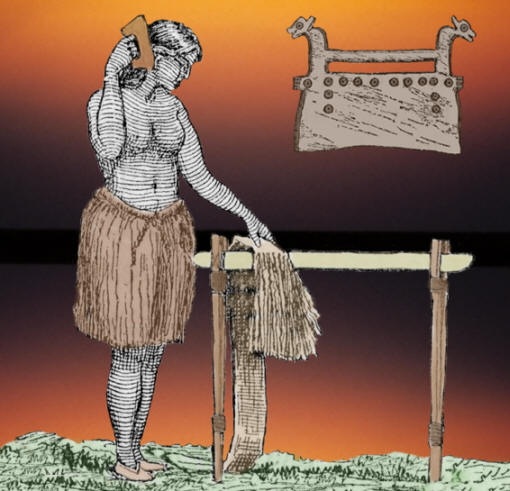
COMPUTER COLORIZED DRAWING OF A
QUINAIELT WOMAN
PROCESSING CEDAR BARK---FROM
1886 "ANNUAL REPORT
OF
THE BOARD OF REGENTS OF THE SMITHSONIAN INSTITUTION
PROCESSING CEDAR BARK
WITH BARK SHREDDER TOOL
CENTRAL WEST COAST OF WASHINGTON
STATE
This drawing shows a woman
using a bark shredding tool in the
northwest coast region of North America. Bark shredders were used to
pound, soften and separate cedar bark strands to make such things as
skirts and capes. The bark shredding tools illustrated in this
drawing were carved from whalebone. |
|
|
An anvil, which is the surface upon which the bark is processed, is also needed to make
barkcloth. The simplest anvils were made of a peeled log or a stone. The
most refined anvils were constructed in ways that were less wearing on
the hands of the person making the bark cloth. One type of anvil uses a
split hardwood log that was laid on top of softer pithier wood.
Hollowing out the underside of the log also gives the anvil a musical
resonance which is considered a desirable quality by Polynesian women.
The first director of the Bishop Museum in Hawaii reported that when he
arrived on the island of Oahu his travels were telegraphed from village
to village by the ringing of tapa anvils. |
|
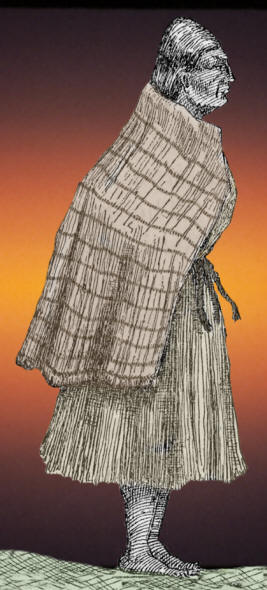
COMPUTER COLORIZED DRAWING OF A
QUINAIELT WOMAN
WEARING CEDAR BARK SKIRT AND CAPE---FROM
1886 "ANNUAL
REPORT
OF THE BOARD OF REGENTS OF THE SMITHSONIAN INSTITUTION
QUINAIELT WOMAN WEARING
CEDAR BARK SKIRT AND CAPE
CENTRAL WEST COAST OF WASHINGTON
STATE
This drawing illustrates a
woman from the central west coast of Washington that is wearing
cloths made of cedar bark. Both the skirt and cape are made of bark
that had been softened by beating with a bark beater. |
|
|
Most of the world's production of bark cloth has been in
countries that are located along and just to the north and south of the
equator. These areas have the most plentiful and best varieties of
trees for making bark cloth. In fact, some of the finest bark cloth is
made in east Polynesia from the inner bark of the paper mulberry that is
specifically cultivated for the purpose. Bark cloth was also produced in other areas
of the world, such as in the
northwest coast of North America, China and Easter Island. |
|
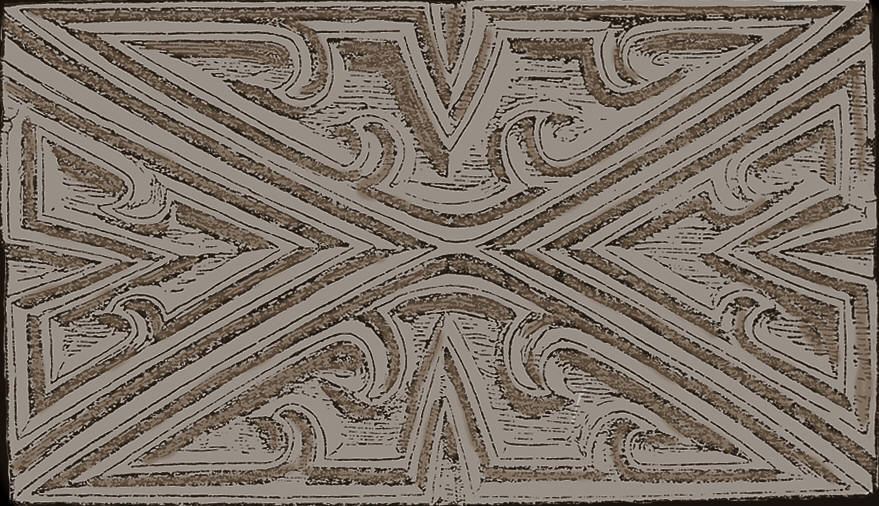
COMPUTER ENHANCED DRAWING OF A WOODEN
STAMP FOR BARK CLOTH---
FROM 1948 SMITHSONIAN INSTITUTION'S "HANDBOOK OF SOUTH
AMERICAN INDIANS," VOL. 3
WOODEN STAMP FOR BARK
CLOTH
YURACARE PEOPLE
COCHABAMBA & BENI DEPARTMENT IN
THE BOLIVIAN LOWLANDS OF THE AMAZON BASIN
This drawing illustrates an example of a wooden stamp that was used
by the Yuracare people of Bolivia to decorate bark cloth. The papery
surface of bark cloth is well suited for the application of various
types of dye and paint decoration. The colors that have been used by
people in countries around the world to decorate bark cloth have
come from many different sources such as plant roots, berries, nuts,
blood and earthen pigments. Carved wooden stamps were used to make
the job of transferring complex designs easier. |
|
|
Every period of time in the events of human history has had
its signature sounds like the breaking of flint to make a stone tool or
a steam whistle marking the beginning of the Industrial Age. The tapping
sounds of bark beaters can still be heard on some Pacific islands. It's been said that a woman could recognize her own
tapa anvil by the sound of its tone. |
|
"REFERENCES"
1886, Willoughby, C., "Indians Of The
Quinaielt Agency, Washington Territory," Annual Report Of The
Smithsonian Institution To The End Of June, 1886, pp. 268 &
269.
1919, Crawford, M. D. C., "The "Tapas" Of The South Seas," Asia,
Journal Of The American Asiatic Association," 1148-1153.
1948, Metraux, Alfred, "Tribes Of The Eastern Slopes Of The Bolivian
Andes," Handbook Of South American Indians, Vol. 3, pp. 494-495.
1961, Heyerdahl, Thor, "Archaeology
Of Easter Island, Vol. I," , pp. 448 & 524.
1978, Kaeppler, Adrienne L., "Artificial Curiosities," p. 263.
1980, Leonard, Anne and Terrell, John, "Patterns Of Paradise, The
Styles And Significance Of Bark Cloth Around The World," (Published by
the Field Museum of Natural history), p. 14.
1984, Stewart, Hilary, "Cedar," p. 124 & 125.
2000, Lal, Brij V. & Fortune, Kate, "The Pacific Islands, An Encyclopedia, Vol.
1" p. 546.
2007, Serie Barford, "Tapa Talk."
2007, Moreno, Manuel Aguilar, "Handbook To Life In The Aztec World,"
p. 263.
2008, Brumfiel, Elizabeth M., Feinman, Gary M.. "The Aztec World,"
p. 112.
|
|
RECENT
LISTINGS HOME
ORDERING |